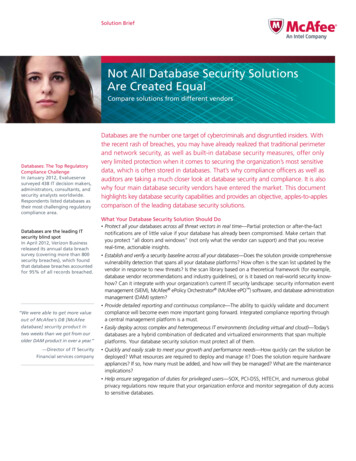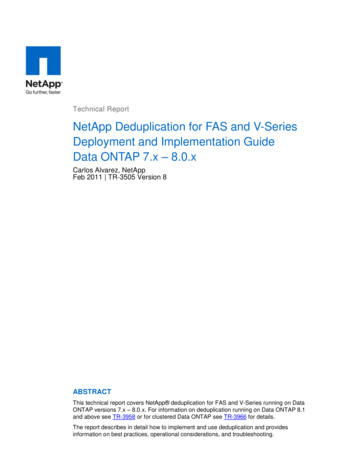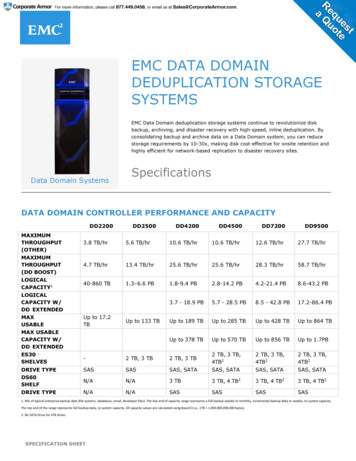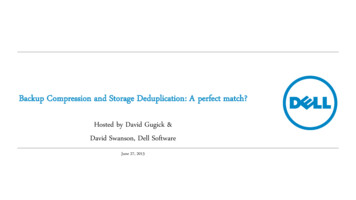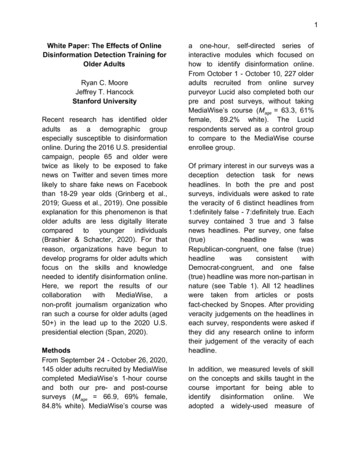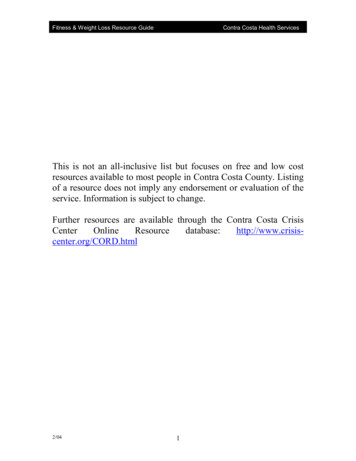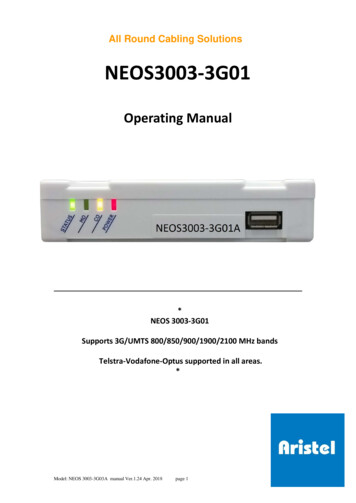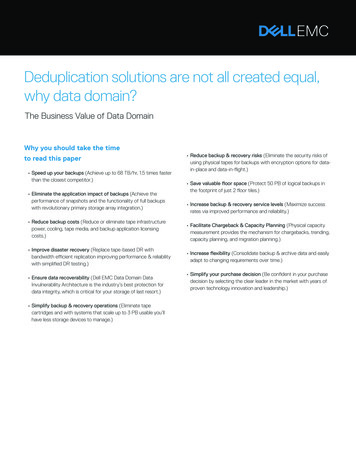
Transcription
Deduplication solutions are not all created equal,why data domain?The Business Value of Data DomainWhy you should take the timeto read this paper Speed up your backups (Achieve up to 68 TB/hr, 1.5 times fasterthan the closest competitor.) Eliminate the application impact of backups (Achieve theperformance of snapshots and the functionality of full backupswith revolutionary primary storage array integration.) Reduce backup costs (Reduce or eliminate tape infrastructurepower, cooling, tape media, and backup application licensingcosts.) Improve disaster recovery (Replace tape-based DR withbandwidth efficient replication improving performance & reliabilitywith simplified DR testing.) Ensure data recoverability (Dell EMC Data Domain DataInvulnerability Architecture is the industry’s best protection fordata integrity, which is critical for your storage of last resort.) Simplify backup & recovery operations (Eliminate tapecartridges and with systems that scale up to 3 PB usable you’llhave less storage devices to manage.) Reduce backup & recovery risks (Eliminate the security risks ofusing physical tapes for backups with encryption options for datain-place and data-in-flight.) Save valuable floor space (Protect 50 PB of logical backups inthe footprint of just 2 floor tiles.) Increase backup & recovery service levels (Maximize successrates via improved performance and reliability.) Facilitate Chargeback & Capacity Planning (Physical capacitymeasurement provides the mechanism for chargebacks, trending,capacity planning, and migration planning.) Increase flexibility (Consolidate backup & archive data and easilyadapt to changing requirements over time.) Simplify your purchase decision (Be confident in your purchasedecision by selecting the clear leader in the market with years ofproven technology innovation and leadership.)
Table of ContentsExecutive summary 4Deduplication systems are not all created equal 4Table stakes or a cut above 4Leaders vs. Followers 4Introduction 4Audience 4Why data domain? technology differentiation & leadership 4Data domain data invulnerability architecture 4Benefits of data domain data invulnerability architecture 5Data domain stream informed segment layout (sislTM) 5Benefits of SISL 5Dell EMC data domain boostTM software 5Benefits of data domain boost 6Variable-length segmentation 7Benefits of variable-length segmentation 7Inline vs. Post process deduplication 7Benefits of data domain inline deduplication 7Massive scalability 7Benefits of data domain scalability 7Data domain for disaster recovery 8Benefits of data domain for disaster recovery 8Physical capacity measurement 8Benefits of data domain physical capacity measurement 8Secure multi-tenancy 8Benefits of secure multi-tenancy 8Oracle optimized deduplication 8Benefits of oracle optimized deduplication 9Protectpoint: the performance of snapshots with functionality of backups 9Benefits of data domain with protectpoint 9Flexibility 9Benefits of data domain system flexibility 102
Consolidation platform for backup and archive 10Benefits of data domain as a consolidation platform 10Hardened security 10Benefits of data domain hardened security 11Data domain virtual edition 11Benefits of data domain virtual edition 11Data domain high availability option 11Benefits of data domain high availability option 11DD Boost solution integration 11Conclusion 123
Executive summaryIntroductionDeduplication systems are not all created equalThere is a common misconception that all deduplicationsystems are created the same and many organizationsare now doing their homework prior to making a purchasedecision. There are certain key things to look for when you areresearching a deduplication storage solution and that is thesubject of this paper. Data Domain, powered by Intel Xeon processors, is uniquely positioned to deliver you tremendousbusiness value with these important capabilities.Table stakes or a cut aboveAll deduplication solutions can reduce your storage andnetwork requirements. However, how efficiently they do it, howfast they do it and whether your critical data can actually bereliably recovered vary greatly. Solutions that are “a cut above”are the ones that don’t simply focus on deduplication storagesavings, but also provide you the scale, performance andefficient replication you require and prioritize protecting theintegrity of your data above all else.Leaders vs. FollowersDell EMC continues to lead purpose-built backup applianceswith 61.4% total market share – 6x more than the closestcompetitor – according to IDC. And with over 70,561Data Domain systems now deployed, we believe the moreyou know about Data Domain technology, the more you willwant to join this group.This paper focuses on Data Domain technology leadershipand differentiation and why it matters to you. The purposeof this paper is to explore the technical and financial reasonswhy Data Domain systems are ideal for backup and archivingin your environment.AudienceThis paper is intended for Dell EMC customers, Dell EMC sales,Dell EMC systems engineers, Dell EMC partners and anyone elsewho is interested in learning more about Data Domain system’sdifferentiating technology and all the unique advantages that itcan provide for your backup and archive data.Why data domain, powered by intel xeon processors: technology differentiation &leadershipData domain data invulnerability architectureEnsuring data integrity should be priority one for the platformprotecting your backup and archive data because they arethe storage of last resort. When you try to recover data fromthis platform, it is likely the only place that data exists. Whenconsidering backup and archive solutions, none of the otherfeatures and capabilities matter if the data cannot be recoveredwhen it’s really needed. No single protection mechanism canprovide protection for all the different ways your data can belost. The Data Invulnerability Architecture includes 4 differentprotection mechanisms that together provide the industry’s bestprotection for data integrity and recovery.Purpose Built Backup Appliances2015 Open Systems Mainframe RevenueEMCSymantecIBMEMC61.4%2015 Total Market 3.3BSource: IDC Worldwide Quarterly Purpose Built Backup Appliance Tracker -Q2 20164HPEBarracudaOthers
End-to-end verification. The best way to know if the data you arestoring is good is to check it after it’s been written and compareit against the checksum of the data that was sent. This is doneinline when the backup is running so any detected errors can becorrected immediately without having to restart the backup job. Fault avoidance and containment. One of the most commonways that data gets corrupted is when new data is appended toit, sometimes overwriting previous data. Data Domain systems,powered by Intel Xeon processors, avoid this possibility by neverappending new data to existing data. The system also includesNVRAM, which protects against data loss in the event of a powerfailure before all data can be written to disk. Fault detection & healing. Once you have stored your datacorrectly, how do you ensure that it stays correct? Over time, bitscan flip or become unreadable and disk drives can fail. On all DataDomain systems, an ongoing background process automaticallydetects and corrects errors on the fly before they become aproblem. In addition, RAID 6 protects against a double drive failureor someone removing the wrong drive in the event of a drive failure.Data Domain systems include a global hot spare drive in every shelf.These hot spare drives will automatically take the place of a faileddrive and a support call is initiated back to Dell EMC to replace thefailed drive. File system recoverability. Even with all of the above protection,there is always the possibility of a catastrophic failure. For manydeduplication systems, these types of failures mean partial or totaldata loss or may take a week or more to recover from. Since dataintegrity is the number 1 design priority, Data Domain system uses aself-describing metadata, so we can completely re-build a system inless than 24 hours in the event of this worst-case scenario.Benefits of data domain datainvulnerability architectureWith the Data Invulnerability Architecture, you can reliablyrecover your critical data and trust that the data will be exactlyas you expect it. No other vendor provides this same level ofattention to data integrity. Data Domain systems check thedata saved to the data that was sent, which ensures your datais stored correctly. In addition, the system takes precautionsnot to trash existing data by never appending new data toprevious data, which ensures your data doesn’t get overwritten.Data Domain systems also protect against data loss dueto power failures or dual disk drive failures or bit flips withbackground data scrubbing and on-the-fly error correction,which ensure your data stays recoverable and correct. Andfinally, unlike most vendors, Data Domain systems leverageself-describing metadata, so the system can rebuild fromscratch in a reasonable timeframe, to ensure you’re up andrunning as quickly as possible. This commitment to ensuring5data integrity should give you confidence to trust Data Domainsystems to protect your data better than anyone else.Data domain stream informed segment layout (sislTM)The foundation for Data Domain’s industry leading performanceis the Stream-Informed Segment Layout (SISL) scalingarchitecture. SISL enables Data Domain systems to perform99% of the deduplication processing in CPU and RAM, whichgives it fantastic performance even with inefficient protocolslike CIFS and NFS. SISL means Data Domain systems do notrely on increasing the number of disks to increase performanceand therefore are not spindle-bound like other deduplicationplatforms. This is why Data Domain systems have dramaticincreases in performance with each successive generation ofIntel processors – every time Intel processors get faster, DataDomain systems get fasterBenefits of SISLThere are 2 important benefits from SISL – faster backups andinvestment protection. Most importantly, since Data Domainsystems are the fastest in the industry, they will help you meettight backup windows in the face of exploding data growth.Secondly, because Data Domain systems performanceincreases with Intel performance, it follows Moore’s Law.This means that future Data Domain systems will continueto realize dramatic improvements in speed and scalability asfuture CPUs are used in new Data Domain systems. As newtechnology is introduced, many of our systems enable youto replace the controller with a next generation model whileleaving all the backup data in-place. This investmentprotection ensures you can dramatically improve backupperformance and scalability without disrupting operations.Dell EMC data domain boostTM softwareDell EMC Data Domain Boost software distributes parts of thededuplication process to the backup server(s) or applicationclient(s), leaving the Data Domain system, powered by Intel Xeon processors, to focus its energy on determining what isunique and writing the new data to disk. With DD Boost, onlythe unique data has to travel from the backup server or clientto the Data Domain system. DD Boost also gives the backupapplication control over replication. The larger the backup shopthe more significant this distribution is. A backup shop with fiveor more backup servers, for example, would have five backupserver resources each doing some of the deduplication effortwith DD Boost. Without DD Boost, the entire deduplicationeffort is being performed by the Data Domain system andall the data must travel from the client to the Data Domainsystem. With some backup applications, the deduplication canbe distributed all the way down to the client and in these cases,the distribution benefit isn’t five (backup servers) to 1, butcould be hundreds or thousands (clients) to 1.
Introduced in DD OS 6.0, the DD Boost file system plug-in(BoostFS) is a standard filesystem interface that installed onthe Linux operating system of your favorite application server.On the client, the filesystem operations conducted on theBoostFS mount point use the Boost protocol to transfer datato and from the Data Domain system. As a result, files anddirectories created on the mount point are actually stored inthe storage-unit on the Data Domain system.spans the entire backup path all the way from the clientto the Data Domain system.By directly accessing the mount point provided by BoostFS onthe client, a third-party data protection application that doesn’thave the specific DD Boost API integration can still realize thebenefits (e.g. de-duplication, dynamic interface group, TLSencryption) provided by the DD Boost SDK through the DDBoost File System Plug-In, or BoostFS. On the client, users/programs/scripts can access the mount point in the same waythey access a local directory.Benefits of data domain boostDD Boost speeds up backups by 50% without changingyour existing backup servers and infrastructure. Doesn’t thatsound great speed up your backups using the same exacthardware? A single controller DD9800 has performance that is1.5 times faster than the closest competitor achieving backupspeeds up to 68 TB/hr!With DD Boost, only unique data has to be sent from thebackup server or client to the Data Domain system. Thismeans up to 99% less data has to be moved across thenetwork - even for full backups - allowing more efficient useof your existing resources. For applications that DD Boost canbe leveraged at the client (Dell EMC NetWorkerTM, Dell EMCAvamarTM, Oracle RMAN, NetVault), this bandwidth reductionIn addition to increased performance, there’s anotheradvantage of distributing the deduplication process that maynot be so intuitive. Specifically, DD Boost actually reducesCPU utilization on the backup server or client even thoughit’s executing parts of the deduplication process. As it turnsout, the CPU cycles required to execute these parts of thededuplication process are actually less than what it takes topush full backups over the network. Aha, now that’s prettycool, huh? With DD Boost, backups run faster, you use lessbandwidth and you reduce the workload for your backup serveror client. Wow! But wait, there’s more.DD Boost also means you don’t have to manage thousandsof physical or virtual tape cartridges greatly simplifying yourday to day production and disaster recovery operations andreducing the time, effort and costs associated with handlingand managing tape cartridges.Even with deduplication, managing replication can be difficultand DR testing can be cumbersome. DD Boost with managedfile replication changes this by providing the backup applicationvisibility and control over Data Domain replication. This givesthe backup application total catalog awareness of all localcopies and any copies that have been replicated to other sitesand increased confidence in your disaster recoverability.Finally, DD Boost also enables automatic load balancing of thebackup workload across all the available paths to maximizeperformance and efficiency. In addition, DD Boost providesautomatic path failover, which improves the reliability of yourWithout DD Boost Deduplication Occurs InlineLANor SANLANor SANBackup ServerApplicationData Domain systemWith DD Boost Deduplication Distributed to App ServerDD BoostApplicationLANor SANLANor SANBackup ServerData Domain system6
backups and eliminates the need to manage mount points.This also ensures your backups continue to run evenif you lose a path resulting in higher backup completionsuccess percentages and less effort spent on re-runningfailed backup jobs.DD Boost for Enterprise Applications also gives applicationowners the control and visibility that they’ve always wantedin addition to all the other DD Boost benefits.Through the new DD Boost file system plug-in (BoostFS), DDBoost is now immediately available for new workloads thatwere previously unavailable and can take advantage of DDBoost benefits. BoostFS can be deployed in minutes, reducingbackup windows and storage capacity. Applications usingNFS to move data to/from Data Domain can easily switch toBoostFS and improve backup performance.Variable-length segmentationData Domain systems, powered by Intel Xeon processors,use variable-length segmentation to break up data streamsfor optimal deduplication rates. Specifically, as a Data Domainsystem ingests data, it intelligently breaks up the stream basedon the natural structure of the data. Then, the system
Dell EMC data domain boostTM software Dell EMC Data Domain Boost software distributes parts of the deduplication process to the backup server(s) or application client(s), leaving the Data Domain system, powered by Intel Xeon processors, to focus its energy on determining what is unique and writing the new data to disk. With DD Boost, only
